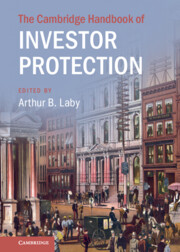Book contents
- The Cambridge Handbook of Investor Protection
- The Cambridge Handbook of Investor Protection
- Copyright page
- Dedication
- Contents
- Contributors
- Acknowledgments
- Introduction: Continuity and Change in Investor Protection
- Part I Institutionalization and Investor Protection
- Part II The Scope of Investor Protection Regulation
- Part III The Regulation of Market Professionals
- 10 Techniques of Regulatory Implementation
- 11 Regulation Best Interest, Customer Trust, and the Move to Make Private Investments More Available to Retail Investors
- 12 Best Execution: An Impossible Dream?
- 13 Equilibrium Investor Protection
- 14 Reputational Bonding and the Birth of Investment Adviser Regulation
- Part IV Alternative Regulatory Regimes
- Index
11 - Regulation Best Interest, Customer Trust, and the Move to Make Private Investments More Available to Retail Investors
from Part III - The Regulation of Market Professionals
Published online by Cambridge University Press: 20 October 2022
- The Cambridge Handbook of Investor Protection
- The Cambridge Handbook of Investor Protection
- Copyright page
- Dedication
- Contents
- Contributors
- Acknowledgments
- Introduction: Continuity and Change in Investor Protection
- Part I Institutionalization and Investor Protection
- Part II The Scope of Investor Protection Regulation
- Part III The Regulation of Market Professionals
- 10 Techniques of Regulatory Implementation
- 11 Regulation Best Interest, Customer Trust, and the Move to Make Private Investments More Available to Retail Investors
- 12 Best Execution: An Impossible Dream?
- 13 Equilibrium Investor Protection
- 14 Reputational Bonding and the Birth of Investment Adviser Regulation
- Part IV Alternative Regulatory Regimes
- Index
Summary
In April 2019, the United States Securities and Exchange Commission (SEC) adopted a long-awaited rule addressing the standard of conduct for broker-dealers and their associated persons.1 As a matter of law, registered investment advisers are fiduciaries; brokers often (perhaps even usually) not.2 For roughly two decades, however, there has been widespread recognition that most customers and clients of those who offer investment advice do not understand the often technical legal distinctions between brokers and advisers, and express the same needs and expectations of trustworthy advice from each. In Section 913 of the Dodd–Frank Act of 2010, Congress prompted the SEC to study and recommend ways to resolve this dissonance, conferring the authority to adopt rules relating to retail customer advice to unify the standard for brokers and advisers. On the assumption that the SEC would not lower the more exacting legal standard for registered investment advisers, uniformity would mean raising the level of broker responsibility by making them fiduciaries, too.
- Type
- Chapter
- Information
- The Cambridge Handbook of Investor Protection , pp. 209 - 222Publisher: Cambridge University PressPrint publication year: 2022

